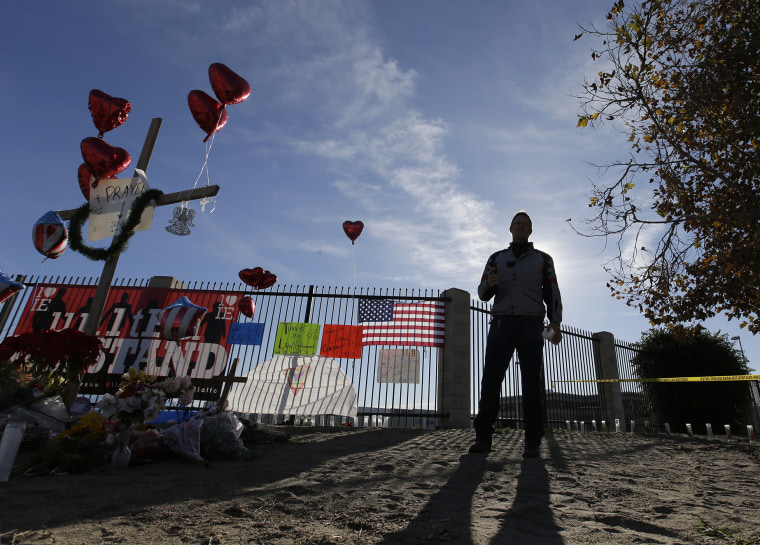SAN BERNARDINO, California -- Just steps outside where a candlelit vigil was held to honor 14 people killed in a violent blaze of bullets, a poster advertised an upcoming gun show.
“WE’VE GOT AMMO!” the banner read.
“BUY-SELL-TRADE!”
The neon-orange signs were splashed across San Bernardino’s roughest looking neighborhoods, covering the blighted and vacant buildings that point to the city’s steep decline.
The sound of gunfire is not foreign to these parts. Even before Syed Farook and Tashfeen Malik stormed an office party and unleashed the deadliest shooting attack in years, gun violence has gripped the city in the form of gang fights that spill out into the streets.
“Shootings are kind of an everyday ‘oh, it happened again,’” said 22-year-old Jalyn Sandoval, an emergency responder for San Bernardino County.
RELATED: San Bernardino residents react to Obama's address: 'We're still scared'
On the national scale, calls for tighter gun laws in the wake of Wednesday’s attack grow strong. Standing from the Oval Office on Sunday night, President Barack Obama made an impassioned plea that even suspected terrorists should not be able to buy guys in the United States as they can now.
In San Bernardino, there’s silence. Faith groups hold prayer vigils. Survivors and the families of victims embrace one another in what sense of safety they can find in their own homes. Even for a city that has wrestled with the carnage of gun violence, few here are talking about reining it in.
Complicating the matter is the fact that terrorism is the likely cause behind the shooting on the Inland Regional Center, which specializes in offering services to the physically disabled. The assailants in the attack had converted their garage into a bomb-making factory. Law enforcement authorities suspect that the couple were gearing up for multiple attacks.
“It’s not just guns -- it’s people. I’d like to feel that I can protect my family to some extent,” said David Lacasse, 39, from nearby Riverside County. “I don’t want my own candlelit vigil.”
In many ways Obama was right when he said in October that mass casualties to gun violence had somehow grown “routine.” Lacasse readily admits that he wasn’t surprised to see a mass shooting touch his town. On a smaller scale, households here have grown accustomed to pain of everyday gun violence. Lacasse said just last week his 18-year-old son lost a close friend to a stray bullet.
California already has some of the tightest gun laws in the country. Licensed residents must be certified and go through a 10-day waiting period before they can buy a gun. Semi-automatic guns and magazines that hold more than 10 rounds of ammo are banned entirely.
RELATED: Full speech: President Obama on combating terrorism
Residents who agree that it should be more difficult for criminals to obtain guns are angered by the realities that they see in their day to day -- gangs are getting their hands on weapons anyway.
“It has taken a lot of young lives,” said April Jones, who works with her husband in helping underserved communities in San Bernardino. “Children are not able to play, to be free and walk out the door and be safe.”
The situation has grown worse since city officials filed for bankruptcy protection in 2012, trying to dig out of a dire financial situation that was crumbling under rapid foreclosure rates and depleted sources of tax revenue. Public services took a major hit, slashing the police force from more than 350 officers down to just over 260.
Meanwhile the street gangs that had left Los Angeles were now gathering a firm grip on communities just to the east. Crime and homicide rates skyrocketed. San Bernardino was already down by the time two gunmen went on a shooting rampage this week.
“We’ve taken a lot of hits lately,” Lt. Mike Madden, one of the first responders to the San Bernardino massacre, said during a press conference. “Some justified, much of it not justified, and it takes a toll, it takes a toll on all cops.”
Just a few days out from the violent terror spree, the community is still adjusting to what has become a new normal.
As a financial aid administrator at a local community college, Melissa Contreras has gone through a number of active-shooter trainings at work. But this shooting hit a little too close to home for her. One of Contereras’ neighbors across the street, a mother to a 22-month toddler, was gunned down in Wednesday’s shooting.
“I have never in all 39 years in my life thought to pick up a gun,” Contreras said. “But now, I want to sign up for a class to learn and train to use one.”
